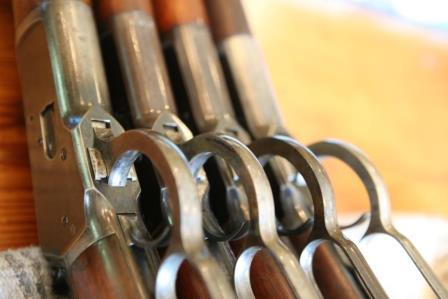Hello MWK,
I assume that you are referring to the parallel striations which show a loss of bluing. This is fairly common on these rifles as the bluing becomes thin and worn off. The multiple striations are a function of the forging process during the manufacture of the steel. This is not restricted to any specific time period but rather related to the existing quality of the bluing finish.
Michael

Model 1892 / Model 61 Collector, Research, Valuation
MWK,
Since there is a small loss of original bluing in the striations it then results in a lightly lower overall % condition rating for the rifle. It is not the striations themselves but the inherent loss of bluing. So yes the overall potential value of the rifle would be a bit lower than an example where there are no striations visible. That image looks like it is from Leroy Merz’s website. Let me know if you have further questions.
Michael

Model 1892 / Model 61 Collector, Research, Valuation
MWK said
Thanks Twobit.I was looking at 1892 Oct barrel in 32wcf and the bluing overall was present and looked remarkably good but you could definitely see the parallel lines. As a condition factor does this hurt the value? I would rate the rifle 70 to 75%.
Thanks
MWK
To me, those lines show honesty and character and would not detract any further from the overall graded condition of the gun. I like the lines.
Don
twobit said
MWK,Since there is a small loss of original bluing in the striations it then results in a lightly lower overall % condition rating for the rifle. It is not the striations themselves but the inherent loss of bluing. So yes the overall potential value of the rifle would be a but loser than an example where there is no striations visible. That image looks like it is from Leroy Merz’s website. Let me know if you have further questions.
Michael
The actual rifle I was looking at is not the one in the photo I used it for reference to show the lines The rifle I looked at is in a little better shape than that of the photo and Unfortunately i was not able to get any photos of it.
My 2-cents on this topic…
I would much rather see (and buy) an old Winchester with the visible forging striations than one without them. In my experience, the forging striations are found on the pre-WW I (older receiver frames). After WW I, it is rare to find a Model 1894 with visible striations.
The striations were created by the forging process, and visually show you where the steel density (hardness) differs. The old style bluing was affected by the density (hardness) of the steel, and it wore faster along those striation lines.
Bert
WACA Historian & Board of Director Member #6571L

Huck Riley said
I learn something new on this site all the time. I have those lines on all my 86s and I thought they were machining marks. Thanks.
Machining marks would be perfectly straight across the length of the receiver… the striations very rarely ever run perfectly straight.
I should have noted in my previous reply, that they lack of visible striations on the pre-WW I receiver frames is more often than not indicative of refinish work.
Bert
WACA Historian & Board of Director Member #6571L

I’m new to this, but learning more all the time. The 1892 rifle I purchased last month, made in 1903 according to the serial number, has these marks on both sides of the receiver. I thought they were scratches from a case or scabbard. It’s nice to know what they really are! It’s a 38 WCF, and I’m delighted to have been able to add it to my small collection.
1 Guest(s)


 Log In
Log In Members
Members Home
Home

 Add Reply
Add Reply Add Topic
Add Topic Offline
Offline







